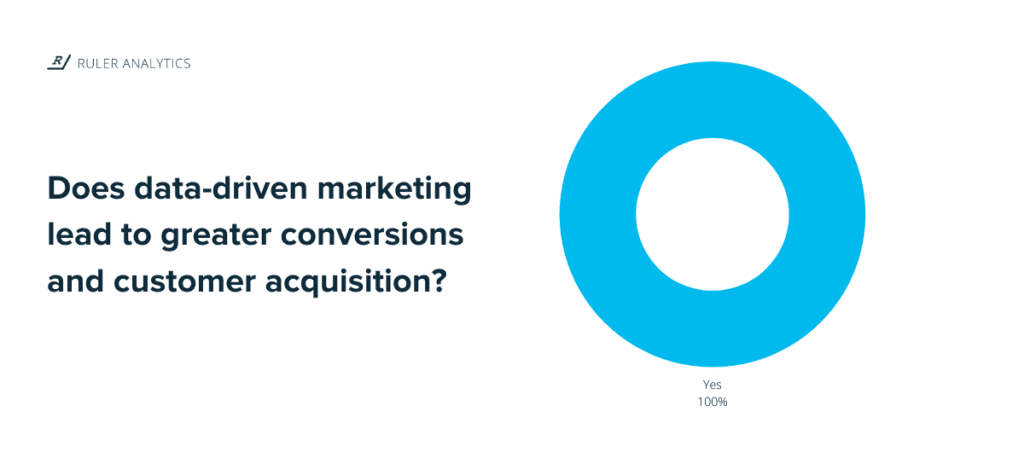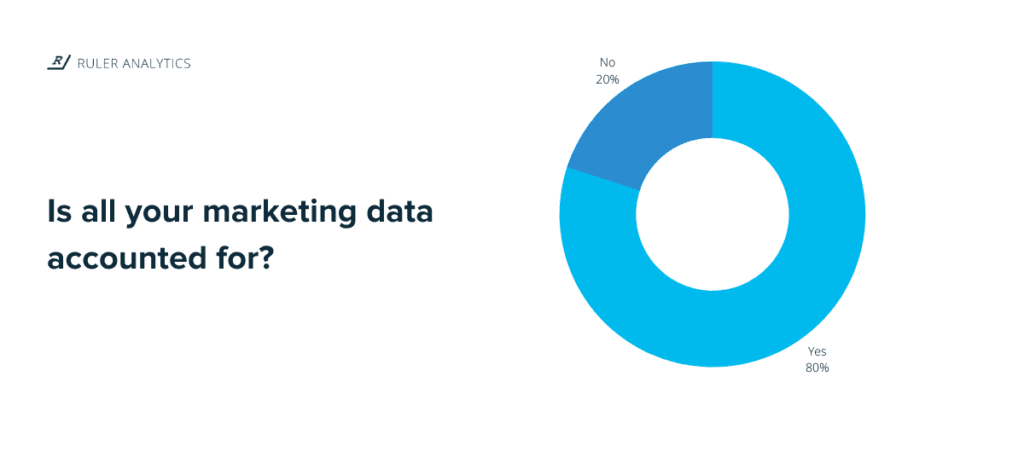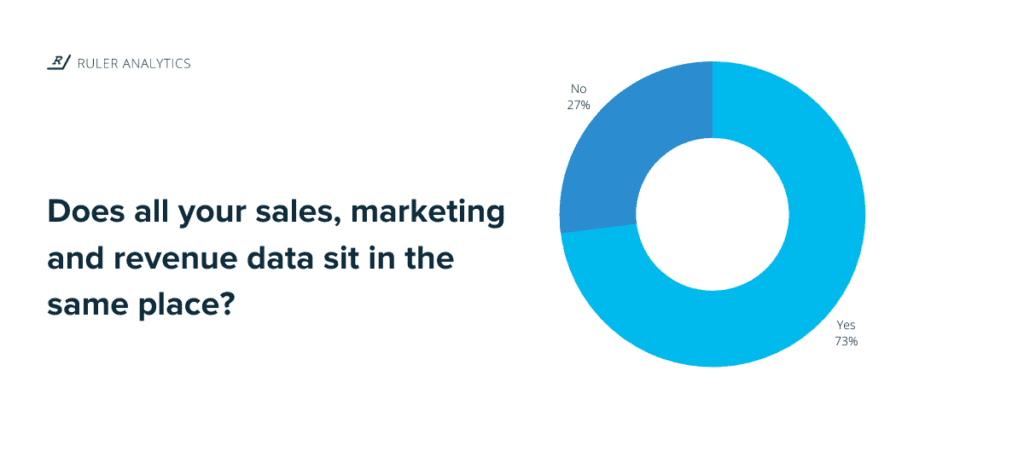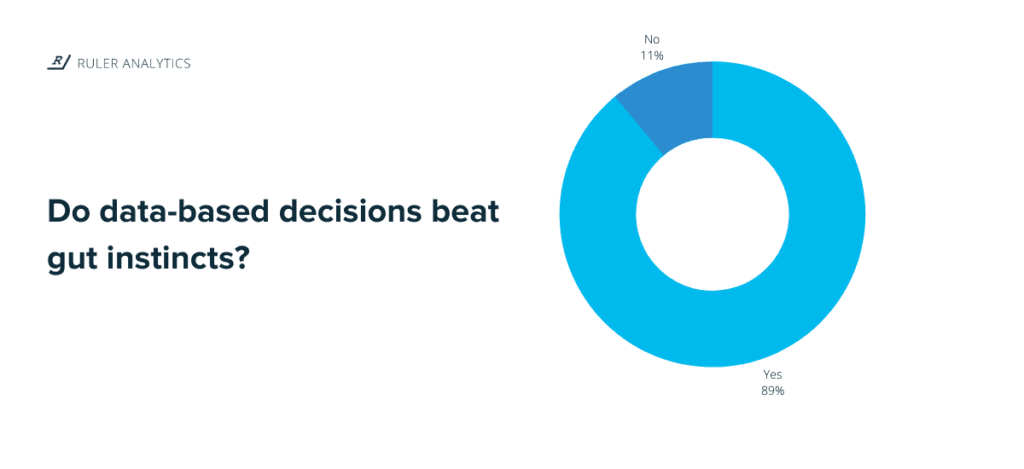Data-driven marketing has the potential to revolutionise your business by supporting growth, reducing costs and increasing team collaboration. We walk you through how to implement it to your marketing stack.
Data is key for any marketer. But collecting and analysing the correct data is key. Without the right data in place, you’ll struggle to make smart marketing decisions that will positively impact your business.
But which data should you prioritise? And how do you collect it? Greg Kozera, Senior Enterprise Account Executive at ELM Learning said, “When you see the bottom line, there aren’t many ways you can argue with that number.”
For some marketers though, it can be hard to get this figure.
Keep reading to find out:
Let’s get stuck in!
A data-driven approach to marketing is where a business makes strategic decisions based on data analysis.
Justin Smith, CEO at OuterBox said, “Listen to your data. Don’t let your own biases or external pressures get in the way of what’s fact and what’s not.”
But how do you get the right data in place? And Carrie McKeegan, MBA, CEO & Co-Founder at Greenback Expat Tax Services added, “Without being able to plug in the correct numbers (or data), you’ll never come up with the right answers.”
By tracking the right metrics, you can quickly see what’s working. And, you can make small changes that will help you optimise and then scale.
100% of marketers that we spoke to said that data-driven marketing leads to greater conversions and customer acquisition.

Data in marketing is key in order to understand how your efforts are working, and what needs improvement.
And when big budgets are involved, making sure you make the right decisions at the right time is vital.
Matt Lally, Founder at TheGiftYak added, “Data-driven marketers are facing a new age of digital advertising. Advertising platforms are changing more than ever and tried-and-true tactics of years passed are no longer working.
“Apple’s iOS privacy changes and Google’s banning of third-party cookies are making it more difficult to be a data-driven marketer. The entire digital ecosystem is shifting. In 2022 and beyond, data-driven marketers that are malleable and constantly learning will be the most valuable.”
Data-driven marketing is a must for businesses looking to optimise their outputs. But there are key benefits you can expect once you implement data-driven marketing.
Let’s walk you through them:
The great thing about data-driven marketing is that you can reach more people.
But, not just more people. More people who are likely to convert.
For account-based marketing (ABM), this is even more important.
It results in much more successful marketing for you as you’ll be spending less money, and less time, but driving more results on your bottom line.
Of course, when you’re reaching higher-quality leads, you’re going to see a knock-on effect on metrics like return on investment or return on ad spend.
With data-driven marketing in place, you can basically ensure you get more bang for your buck. And, you can easily identify room to grow and areas where you can spend less and gain more.
Understanding your customer journey stages is critical. With data-driven marketing, you can easily identify how your content and campaigns drive each stage.
And with that, you can better optimise each stage to move leads along the funnel.
Related: How to build a lead generation funnel
Data-driven marketing doesn’t need to be difficult to achieve.
The issue that marketers currently face is the disconnection of data.
Think of it like this. Your data is in silos.
We found that 20% of marketers struggle to account for all of their marketing data.

You use your website to drive new leads.
But the data on leads is lost at this point. While you might be able to count a new lead, you can’t see which campaigns and content they engaged with.
And worse, when they convert, their revenue data is locked in your CRM.
To achieve data-driven marketing, you need a tool that will help you link and analyse this data. Marketing attribution tools can help you link your revenue data back to your marketing campaigns. This insight will help you understand which channels are working best to drive you revenue, not just traffic or leads.
💡 Pro Tip
Marketing attribution is a valid option when considering how to accurately assess your marketing’s impact on your revenue. Ruler Analytics can help you identify which channels and campaigns drive the most in sales.
We spoke to marketing professionals to get their top tips for achieving data-driven marketing.
They had these top tips to share:
The first way to achieve data-driven marketing is to get the right tools in place.
Dave Smithbury, Head of Growth at Ruler Analytics said, “Data is vital to a marketing stack. But getting the right data in place isn’t always easy. Marketing attribution is a really valuable tool for marketers looking to collate their leads and revenue data.”
We found that 27% of marketers said that all of their sales, marketing and revenue data did not sit in one place.

Daniela Sawyer, Founder & Business Development Strategist of FindPeopleFast added, “You can achieve data-driven marketing by using a Unified customer data platform, AI-based proactive analysis & contextual interaction. With the help of these tools, you can extract the data of customer’s experience with our business, like what issues they are facing with our products or services & also their feedback.”
CJ Xia, VP of Marketing and Sales at Boster Biological Technology said, “I would recommend collecting the data and invest in proper technology. Focus on identifying the ideal data that helps you answer your specific business questions. Keep in mind your business’s strengths, already collected data, and your needs.
Investing in proper technology makes the difference between average and great results. A well-designed data-driven management platform can help to manage disparate data points easily. The easier it is to understand your data, the better informed you will be about the decisions.”
Data is important. We know that. But ensuring you’re collecting the right data can make a huge difference.
Tyler Wall, CEO and Founder of SD Bullion said, “Collect the right data. There’s a lot of data you can collect, but it’s important to know what your business needs and what your priorities are. Making the right decisions will depend on the quality and relevance of data that you have. Keep them organized, optimized, and updated too.”
You’ve got your main marketing metrics like ROI and customer acquisition cost. But there are lots of data points that pull into this.
Ryan Jones, SEO Specialist, Land of Rugs said, “My biggest tip for marketers looking to make data-driven decisions is to analyse all forms of data. It is all well and good looking at your top-performing page organically, but what if it doesn’t generate any revenue? Or what if its conversion rate is terrible? If you have this data, you can ensure you are testing and making changes to exactly the right pages. There’s no point drilling budget into changing a page that accounts for 2% of your revenue when it could be spent improving a page that accounts for 10%.”
And remember, your data isn’t just quantitative. Nathan Thompson, Founder at KAHL said, “Don’t go hell for leather on the data and ignore your qualitative insights, such as review data and customer support centre contact. Never get too detached from the frontline of your business and what your customer pain points are; they too will evolve as you grow.”
Plus, you need to assess lots of data points given the sheer number of marketing channels and campaigns going on at any given time.
Cedric Dussud, Co-Founder of Narrator agreed, “The most important thing is to have data in one place instead of leaving siloed. For example, to properly understand lead attribution you’ll need data from all ad sources. If you’re using multiple ad networks they’ll each optimistically claim attribution because they don’t know about each other. Being properly data-driven now requires a data warehouse and ideally an analyst that can manage it. In my experience, it’s always been worth the cost.”
Data isn’t subjective. You need to incorporate customer journeys and customer insights into your data analysis. Mayank Batavia, Head of Marketing and Partnerships at QuickEmailVerification said, “As marketers get access to more data, it’s important to not lose sight of information that can’t be boiled down to numbers.”
Ryan Rottman, Co-Founder and CEO at OSDB Sports added, “When taking a hard, targeted look at your data-driven marketing decisions, it’s important to factor in a little humanity as well. While the data doesn’t lie, we also have to keep in mind that certain data may affect different demographics in a variety of ways.
This is yet another reason to really consider segmenting your audience, so that you’re collecting specific data for the group for which the results most closely apply. This enables you to have a clear view of current positioning, along with what you can forecast based on the information you’ve gathered.”
Isabel Pak, Lead Digital Marketer at Business One on One added, “The data-driven approach to marketing can be challenging given that the amount of data that can be collected can be daunting. But it is this kind of data that brands need to improve their sales, branding, products, and pricing. For starters, I would recommend focusing on analyzing the information from your website (using Google analytics), social media, email, conversion rates, and ROI. By getting to know your clients better, you are better equipped to make better decisions.”
Do you have set goals for your business? In order to scale, your team needs to have plans in place to scale and grow.
David Cusick, Chief Strategy Officer and Executive Editor at House Method said, “Set clear and precise goals. These should be defined before you analyze data. Knowing what you want to achieve allows you to set key performance indicators (KPIs) that are most relevant to your business. That’s what make the information you derive from your data more valuable.”
Jessica Ulloa, Community Manager at MyPerfectResume added, “The best way to make the right data-driven decisions is by identifying your company’s objectives first. Your objective could be to increase your site’s traffic, gain more subscribers, or increase brand awareness. Identifying one main goal will allow you to create an appropriate business plan and help you determine which KPIs to analyze and measure.”
By looking at your marketing as an overall, you can then work down and get granular with your data.
Andrew Maff, Founder and CEO of BlueTuskr agreed, “Always start high-level then work your way deeper. Specifically, with paid advertising, we see a lot of people make decisions based on individual platforms, which is good but, because of the fluidity of most customer journeys, it’s not always that simple. If you made some big adjustments on one platform or maybe increased your budget, you should always look at how that may have affected the other platforms using your high-level data before making another change.”
Ian Sells, CEO at RebateKey added, “Don’t base your actions on just one-time events. Study the trends. Do data triangulation if possible; that is, if you’re going to use data, use several sources. Look at previous campaigns and different marketing strategies you’re using. You’re likely to see something there.”
💡 Pro Tip
Remember, Ruler Analytics allows you to report on a single source of truth. You can look at the lead source for a holistic view of your performance and then drill down into campaign, landing page, keyword and more for a forensic approach to optimisation. Book a demo to see it in action.
Remember, data can only get you so far.
Alexandra Zamolo, Head of Content Marketing at Beekeeper said, “Data definitely plays a huge part during the decision-making process – especially when it comes down to marketing. But the thing is, if you’ve been in the game for a while, you’ve probably discovered quite a bit through trial-and-error, and you’ve developed what might be referred to as “instincts.” You know when something feels right, and it’s even better when the data backs it up. Try to let the two work in tandem, and you’ll see the direction of your marketing campaigns change for the better.”
Viola Eva, Founder at Decoding Zeitgeist added, “Data has definitely pointed me in the right direction, especially in terms of SEO and similar areas. However, when it comes to marketing, many value their instincts over what they see on paper. Of course, this also requires a particular level of experience, as well as the bravery that it takes to go against the data. Still, monitor your data regularly, as you’ll want to make any needed campaign changes as quickly as possible. But, try to lean on the data for knowledge and advice, but trust in your instincts to make the right decisions.”
While marketers agreed instincts were important, 89% agreed that data-based decisions beat gut instincts overall.

Travis Killian, Owner and CEO at Everlasting Comfort agreed, adding, “I look at things this way – data should be the guiding force that drives your decision-making process. However, there has to be room for human emotion and those gut feelings that often lead to positive outcomes. And if you’ve been in your particular niche for some time, it’s even more important to pay attention to your instincts, as you have the experience to back them up.”
Data-driven marketing isn’t impossible to achieve. With the right tools and processes in place, you can easily see what’s working and optimise your efforts.
By viewing your marketing data by its impact on revenue, you can easily identify which channels, campaigns and keywords bring in the most sales, not just traffic, or leads.
Ruler Analytics is the perfect tool to help you bridge this gap. It will collate and collect key data on your leads and feed it into the key marketing apps. It leaves you with the data you need, where you need it most.
Not sure how it works? Read how Ruler Analytics can attribute your closed revenue back to your marketing.